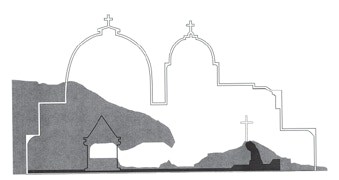Jesus is laid in the tomb (Mark 15:46).
The Aedicule is Station 14. It’s hard to look at the large boxy structure and think of it as a tomb though. But it is, or rather was. When the tomb was found in the 4th century, the hill around it was dug out and it was enclosed by the Aedicule.

Over the last 2,000 years, things have changed drastically, and the Aedicule evolved into what it is today.

So, imagine the area around the Aedicule being dirt and rock. Inside is the slab of stone that was part of the tomb in which Jesus was laid. It’s had a rough go over the years as early pilgrims chipped away pieces to take with them.
There are a couple of times when visiting the Aedicule is easiest. First thing in the morning when the church opens is the best time to visit on any day.
So, if you are an early riser and your tour group doesn’t start until 7 or 8, head down to the Church of the Holy Sepulchre around 5 or 5:30am and you will probably have free reign. Groups start to meander in around 6:30am.
Tuesdays are the slowest tourist days. And Sundays, particularly around lunchtime, are downright awful.
- What is the Via Dolorosa?
- Station 1: Jesus is condemned to death
- Station 2: Jesus takes up his cross
- Station 3: Jesus falls for the first time
- Station 4: Jesus meets his mother
- Station 5: Simon of Cyrene helps Jesus
- Station 6: Veronica wipes the face of Jesus
- Station 7: Jesus falls for the second time
- Station 8: Jesus meets the women of Jerusalem
- Station 9: Jesus falls for the third time
- Station 10: Jesus is stripped of his garments
- Station 11: Jesus is nailed to the Cross
- Station 12: Jesus dies on the Cross
- Station 13: Jesus is taken down from the cross
- Station 14: Jesus is laid in the tomb

